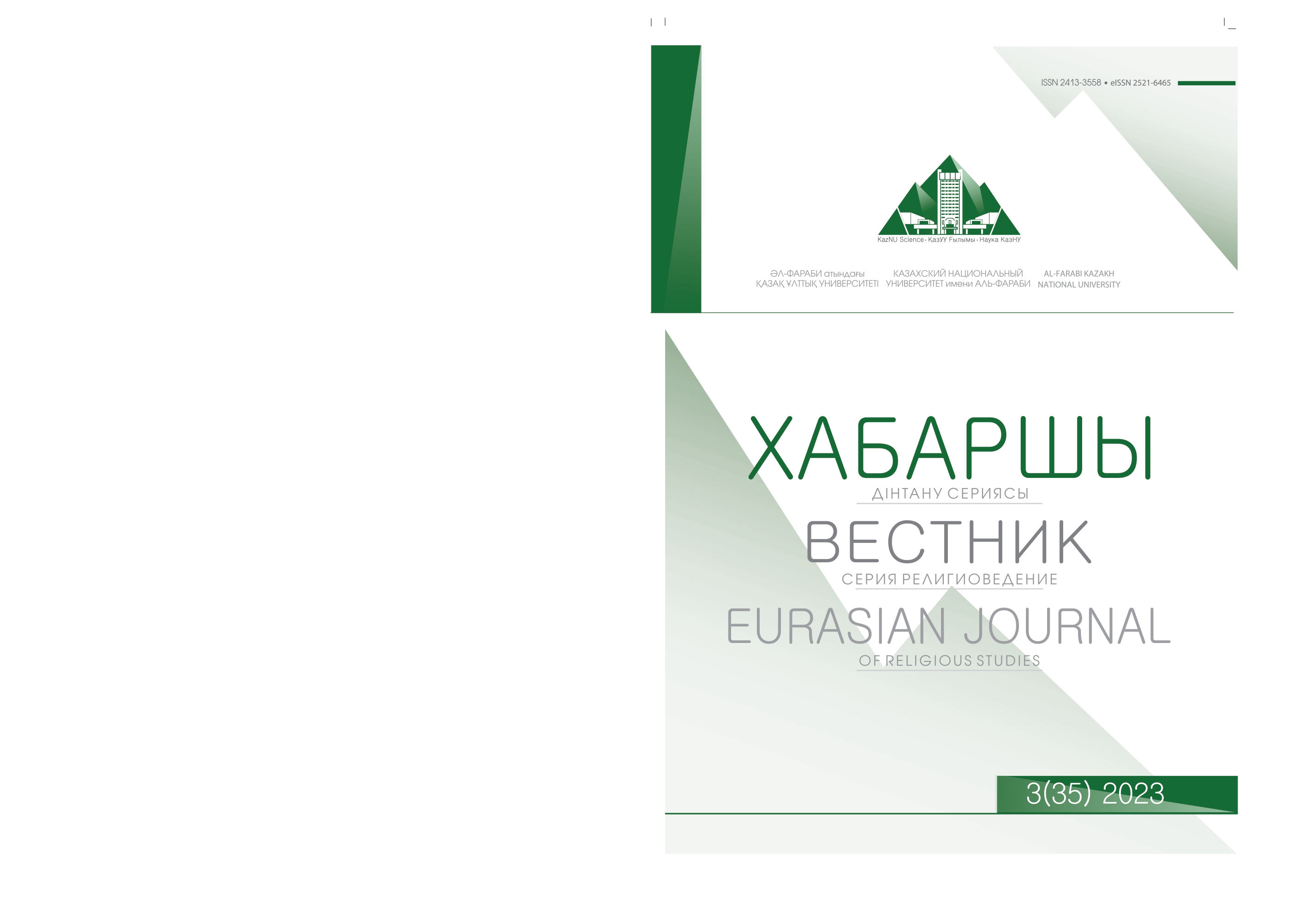Social and economic inequality in Kazakhstan: the contextual factor of religious identity
DOI:
https://doi.org/10.26577//EJRS.2023.v35.i3.r1Keywords:
social structure, socio-economic inequality, religious identity, faith, religious beliefAbstract
The systemic changes occurring in Kazakhstan since the 1990s have been driven by a socio-economic crisis and its corresponding consequences for the living standards of the population. This includes a decrease in per capita income and a rise in income inequality. Indicators of the social standard of living have exhibited signs of a transformational crisis alongside a clear trend of declining systemic measures, encompassing macroeconomic levels and social indicators, including the potential of the healthcare and education systems. Despite recent improvements in the country's socio-economic indicators, significant levels of inequality and differentiation persist in Kazakhstan, with a deeper impact on rural areas than urban ones. The aim of this article is to investigate religious identity as a significant factor not only in determining social and economic inequality but also in elucidating the mechanisms underlying this relationship. A sociological study conducted in various regions of Kazakhstan confirms empirical connections between religion, social status, and material income, while also uncovering the reasons behind such patterns. This article was prepared as part of a grant funded by the Committee of Science of the Ministry of Education and Science of the Republic of Kazakhstan (AR 19679699, "Religiosity/spirituality, well-being and identity of Kazakhstani youth: a comparative country study").
Keywords: social structure, socio-economic inequality, religious identity, faith, religious belief.
References
Habermas J. Eine Art Schadensabwicklung: kleine politische Schriften VI. –Berlin: Suhrkamp Verlag, 1987. – 179p.
Кабиденова Ж.Д., Рысбекова Ш.С. Религиозная идентичность: анализ основных определений и концептов // Вестник КазНУ. Серия философия. Серия культурология. Серия политология. –2015. –№1 (50). –С.53–57.
Krylov A.N. Religiöse Identität Individuelles und kollektives Selbstbewusstsein im postindustriellen Raum Deutsche Kurzfassung des Buches Begleitbeiträge. Religiöse Identität: Individuelles und kollektives Selbstbewusstsein im postindustriellen Raum. –Berlin: Verlag Ikar, 2012. – 306p.
Schweitzer F., Friedrich R. Lebensgeschichte und Religion. Religiöse Entwicklung und Erziehung im Kindes- und Jugendalter // Gütersloh. –2004. –№2 (1). –P.235–252.
References
Andersen R., Curtis J. (2012) The polarizing effect of economic inequality on class identification: Evidence from 44 countries. Research in Social Stratification and Mobility, vol.30, no1, pp.129–141.
Backhaus J., Mueller F. (1994) On Sombart. Review of Social Economy, vol.52, no.2, pp.48–71.
Bourdieu P. (1987) What Makes a Social Class? On The Theoretical and Practical Existence of Groups. Berkeley Journal of Sociology, vol.32, no.1, pp.1–17.
Burova E., Sagikyzy A., Hejazi S. (2022) Indicators of the process of religionization. Eurasian Journal of Religious Studies, vol.30, no2, pp.23–36.
Buttrick N., Oishi S. (2017) The psychological consequences of income inequality. Psychological Compass, vol.11, no32, pp.1–12.
Delhey J., Steckermeier L. (2020) Social Ills in the Rich Countries: New Evidence on Levels, Causes, and Mediators. Social Indicators Research, vol.149, no1, pp.87–125.
Fowler J. W., Dell M. L. (2006) Stages of Faith from Infancy Through Adolescence: Reflections on Three Decades of Faith Development Theory. The Handbook of Spiritual Development in Childhood and Adolescence, vol.1, no2, pp.34–45.
Giordan G. (2016) Spirituality. Handbooks of Sociology and Social Research. - Cham: Springer, 209p.
Goffman, E.: The Presentation of the Self in Everyday Life, 1959; ders.: Characteristics of Total Insitutions. In: Stein, M. u.a. (Hg.): Identity and Anxiety. Glencoe 1960. -S. 449-479.
Habermas J. (1987) Eine Art Schadensabwicklung: kleine politische Schriften VI. - Berlin: Suhrkamp Verlag, 179p. (in German)
Hardy S. et al. (2012) Religiosity and adolescent empathy and aggression: The mediating role of moral identity. Psychology of Religion and Spirituality, vol.4, no3, pp.237–248.
Jaeger M. M. (2009) Equal Access but Unequal Outcomes: Cultural Capital and Educational Choice in a Meritocratic Society. Social Forces, vol.87, no4, pp.1943–1971.
Kabуdenova Zh., Rysbekova Sh. (2015) Religioznaya identichnost': analiz osnovnyh opredelenij i konceptov [Religious identity: analysis of the basic definitions and concepts]. KazNU Bulletin. Philosophy series. Cultural science series. Political science series, vol.50, no1, pp.53–57. (in Russian)
Kim S., Esquivel G. (2011) Adolescent spirituality and resilience: Theory, research, and educational practices. Psychology in the Schools, vol.48, no7, pp.755–765.
Krylov A.N. (2012) Religiöse Identität Individuelles und kollektives Selbstbewusstsein im postindustriellen Raum Deutsche Kurzfassung des Buches Begleitbeiträge. Religiöse Identität: Individuelles und kollektives Selbstbewusstsein im postindustriellen Raum. Berlin: Verlag Ikar, 306p. (in German)
Luckmann T. (2019) The new and the old in religion. In Social theory for a changing society. New York: Routledge, 188p.
Sadri A. (1985) Max Weber’s Sociology of Religion as a Sociology of Intellectuals. State, Culture, and Society, vol.1, no2. pp.85–106.
Schwadel P. (2016) Social class. Handbook of religion and society. Cham: Springer International Publishing, 371p.
Schweitzer F., Friedrich R. (2004) Lebensgeschichte und Religion. Religiöse Entwicklung und Erziehung im Kindes- und Jugendalter, Gütersloh, vol.1, no2, pp.235–252. (in German)
Steinman K. et al. (2008) The Dose-Response Relationship of Adolescent Religious Activity and Substance Use: Variation Across Demographic Groups. Health Education & Behavior, vol.35, no1, pp.22–43.
Vaughn M. et al. (2014) Dropping out of school and chronic disease in the United States. Journal of Public Health, vol.22, no3, pp.265–270.
Weber M. (2002) The Protestant Ethic and the Spirit of Capitalism. - New York: Routledge, 128p.
Worthington E. et al. (2011) Psychotherapy Relationships That Work. - New York: Oxford University Press, 214p.




